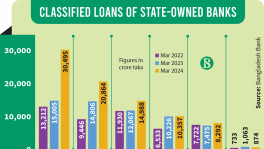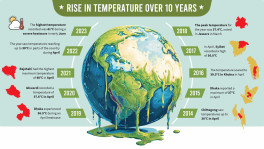We’re sloshing toward economic regime change
Markets are shifting toward a world where the US could underperform, steeper inflation accompanies shorter business cycles, and investments trend toward value

Eureka!
Archimedes's principle can be useful to markets. When a large object drops into a pool, it will displace a lot of liquid that must subsequently go somewhere. The Greek mathematician and physicist discovered this by getting into a bathtub. The principle is also at work in world markets.
The return of inflation, and with it the return of a Federal Reserve that's actually prepared to tighten financial conditions, has displaced many assumptions in the US and is sending money coursing through other parts of the global economy. This could help the market and economy find their way to a self-righting mechanism, but the mess created also brings the risk of fresh accidents. We are witnessing a succession of dramatic shifts in the tectonic plates of financial markets and the economy. It's fairly clear what is happening, but not yet clear where this process will end, and how swiftly it will work.
As ever, there is a risk of over-determining a narrative, or reverse engineering an explanation to fit disparate events. I'm trying to avoid that, but the comeback of inflation in the US is, at the least, contributing to displacements across the world.
US Growth Is Back
The latest gross domestic product growth numbers were emphatic and strong. Excluding the freak quarter a year after the Covid slowdown, when year-on-year growth appeared to go through the roof, the US economy was expanding by the end of 2021 at its fastest since 1984 — the year Ronald Reagan pronounced "morning in America" and won reelection in a landslide.

Viewed with only a little hindsight, the scale of the Covid shock grows even more apparent and it is completely in line with common sense that it would prompt a change in regime. Looking before 1984, however, we see that growth faster than this used to be quite a common occurrence, and that economic cycles were much shorter. To demonstrate that over an even longer period, Deutsche Bank AG's resident financial historian, Jim Reid, produced this chart of the length of every business cycle in the US dating back to before the Civil War:

Even if we date the current cycle from the trough of the Covid shutdown in April 2020 (and many would say that was an interruption of a much longer era of growth that started in the summer of 2009), then it's already longer than many US economic cycles since 1854. Much lengthier ones seem to have arrived, along with a typically slower rate of growth, in 1982. In other words, the long cycles of the last four decades didn't exist when rising prices were a fact of life. They've only become the norm since Paul Volcker tamed inflation. This implies that we should be ready for this cycle to be much faster than its recent predecessors.
That certainly seems to be where the Treasury market is. Since Jerome Powell's press conference Wednesday, the yield curve (the gap between two- and 10-year yields) has flattened dramatically. Very unusually, both ends of the curve contributed, with shorter yields rising sharply while longer yields fell. The curve has a mutually reinforcing relationship with the Fed's monetary policy. Generally, when the economy is strong and in danger of overheating, the curve steepens (longer yields will be much higher, reflecting the belief that rates must rise), and this will prompt the Fed to start tightening. When the curve inverts, a classic and dreaded signal of an approaching recession, the market is saying that rates will be lower in 10 years than in two years — another way of saying that the Fed has tightened too much and will need to start cutting. The Fed generally has no choice but to take the hint.
What is startling about this yield curve flattening is that it's come so soon before the Fed has even started raising rates. If the curve swiftly moves to inversion, it grows far harder for the Fed to carry on with its hiking program:

The market is behaving this way because it expects inflation to force the Fed to bring forward its rate hikes, but not to increase the eventual amount by which it needs to raise. The following chart from BCA Research compares implicit market-based fed funds future expectations with the official projections from the Fed's governors, most recently updated in the "dot-plot" published last month. The market now thinks that rates will be raised at each of the next three Federal Open Market Committee meetings, and perhaps as many as five increases this year. That's a faster rate of tightening than the Fed currently expects. But then, the market expects the hiking campaign to end at 1.75%, while the Fed's governors are braced to inflict a lot more pain than that:

Why does the market believe this? Because it ultimately thinks that the Fed will be unable to carry on that much longer, and that this cycle will be a short one. Expectations for inflation more than a year hence have barely changed over the last six months, despite the startling and surprising rise in a range of prices over that time, as demonstrated by this chart from Barclays Plc:

The good news for the Fed is that this implies high confidence that it will soon regain control. The bad news is that it suggests uncomfortable things about growth.
Global Repercussions
The rise in shorter US bond yields has had some significant knock-on effects, prominently on the dollar. The widely followed dollar index is now stronger than at the beginning of 2020. The turnaround in expectations for the Fed has also turned around expectations for the currency, which appears to be in a clear upward trend once more:

Archimedes's principle is at work here. The dollar cannot rise in a vacuum. Most significantly in the current environment, the Chinese yuan dropped by the most in almost a year, arresting a steady strengthening since it had fallen to more than 7 yuan per dollar during the tariff war with then-President Donald Trump in 2019, and again during the first wave of the pandemic two years ago:

As the chart suggests, the narrowing in the spread of Chinese over US yields has gone so far that the yuan more or less had to weaken. This should relieve some of the pressure on China, where officials are battling to keep growth somewhere close to its trajectory of the last few decades. On a broad basis against a trade-weighted range of currencies, China's currency is about as strong in real terms as authorities have allowed in the last decade. This is true whether we adjust for differences in consumer price inflation in different countries, or for differences in producer price inflation, which is much higher in China. The following chart uses indexes developed by JPMorgan Chase & Co.:

China could do without an unduly strong currency at present, because confidence in its private sector is collapsing. The CSI 300, a composite of the biggest stocks in the mainland exchanges of Shanghai and Shenzhen, has now dropped more than 20% from its peak almost a year ago. Chinese ADRs quoted in the US, buffeted by the clampdown on the private sector and continuing strain in relations with Washington, are now down more than 50% from the peak:

Is this a precursor to an attempt by China to inject liquidity into its economy? Many believe so. The government wants to rein in the serious over-extension of credit, particularly in the property sector. But if things get bad, Beijing might yet backtrack. More liquidity from China would change a lot of assumptions. After a couple of years when China's currency has dropped from attention, close monitoring will again be necessary.
Oil and the Russian Bear
While talk in financial markets is centered on monetary policy and inflation, the chances of an armed conflict over Ukraine involving Russia continue to be very real. Investors are assuming that neither Russia nor the US and its NATO allies will get involved in a protracted military confrontation; it would be in nobody's interests. But the risk of economic sanctions to punish Moscow, which would have the effect of pushing up oil prices, is a different matter
Hence, Brent crude is now its most expensive since an epic fall in 2014 as the OPEC cartel lost discipline. What's strange is that the dollar and the oil price usually have a strong inverse correlation. All oil transactions are denominated in dollars, so a rising oil price should automatically lead to a falling dollar, and vice versa. As the chart below shows, this relationship has endured consistently for 15 years — but now, oil and the dollar have parted ways:

Further oil price rises might slow or reverse the dollar's advance. Meanwhile, the oil price has also been a reliable supporter of the Russian stock market. Given the economy's deep reliance on energy, this is no surprise. But, again, oil's latest rally has been coupled with underperformance by Russian stocks:

Whatever happens in Ukraine over the next few weeks, investors are convinced that the Russian economy is in trouble. Meanwhile, eastern Europe has managed to avoid being caught up in the latest Russian selloff. But the region still looks vulnerable if the Ukraine crisis deepens. Stock markets in Russia and central and eastern Europe have had a horrible decade:

What Next?
The laws of economics are nowhere near as precise as the laws of physics, unfortunately. But the hypothesis that we are in the midst of an economic regime change away from four post-Volcker decades of low inflation looks ever-more probable. As many around the western world seem fed up with the outgoing order, this may be no bad thing. But it will likely drive changes in investment assumptions as well. The trend for falling yields over time is the most important. Two others are worth noting.
First, the trend for US outperformance over the rest of the world's stock markets has gone on a while. History suggests that protracted periods of US underperformance can and do happen. After 13 years of persistent US dominance, it would be no surprise if it occurred again:

If the regime is about to turn, it might also be as well to reassess the prospects of value compared to growth. Value has outperformed recently, of course, but a longer perspective suggests it could go much further:

Nothing happens in a straight line, and there may be more displacements. But it makes sense to navigate on the assumption that the rally in value stocks will continue, and that US dominance is finite.
Survival Tips
Some suggestions for podcast listening that might dampen your despair at what has become of the media. On The New Bazaar, Bloomberg Opinion colleague Tyler Cowen talks for an hour with former colleague Cardiff Garcia in defense of markets and modern media and their effect on the arts. He says they've led to a boom of creativity, and he's right about that (though it's a shame they also led to a boom in hateful behavior.) On Offline, former Obama speechwriter Jon Favreau talks to Jenny Odell on "resisting the attention economy," or how to survive on social media. To remember an older and slightly more innocent world, you could try listening to I'm Sorry I Haven't a Clue, a long-running BBC radio panel show. Barry Cryer, a regular panelist who wrote gags for just about every British comedian in my lifetime, has passed away at 85. His death led all the BBC's news bulletins. It's old school, and still very funny. Have a good weekend everyone.
John Authers is a senior editor for markets. Before Bloomberg, he spent 29 years with the Financial Times, where he was head of the Lex Column and chief markets commentator. He is the author of "The Fearful Rise of Markets" and other books.
Disclaimer: This article first appeared on Bloomberg, and is published by special syndication arrangement.


 Keep updated, follow The Business Standard's Google news channel
Keep updated, follow The Business Standard's Google news channel
















